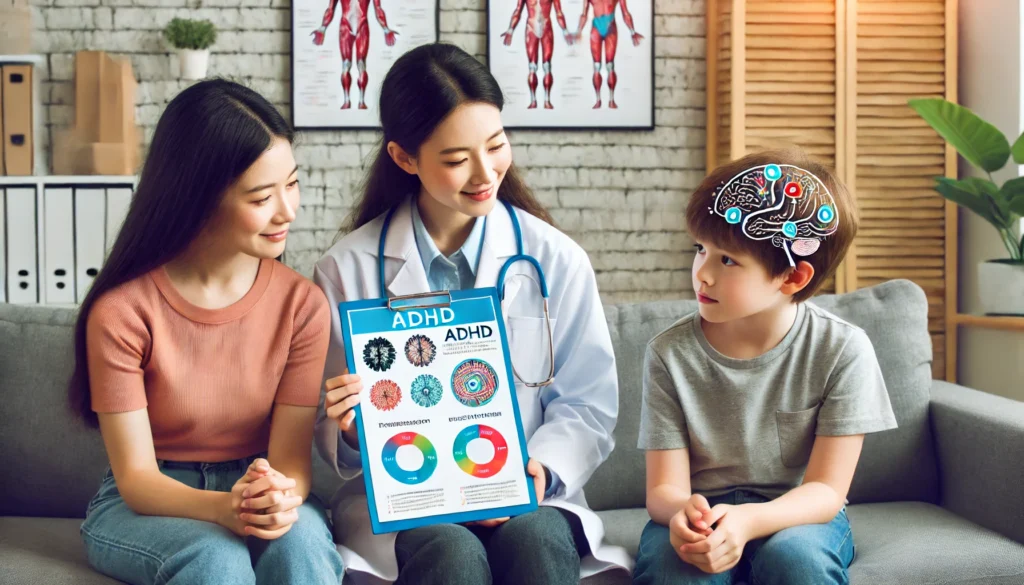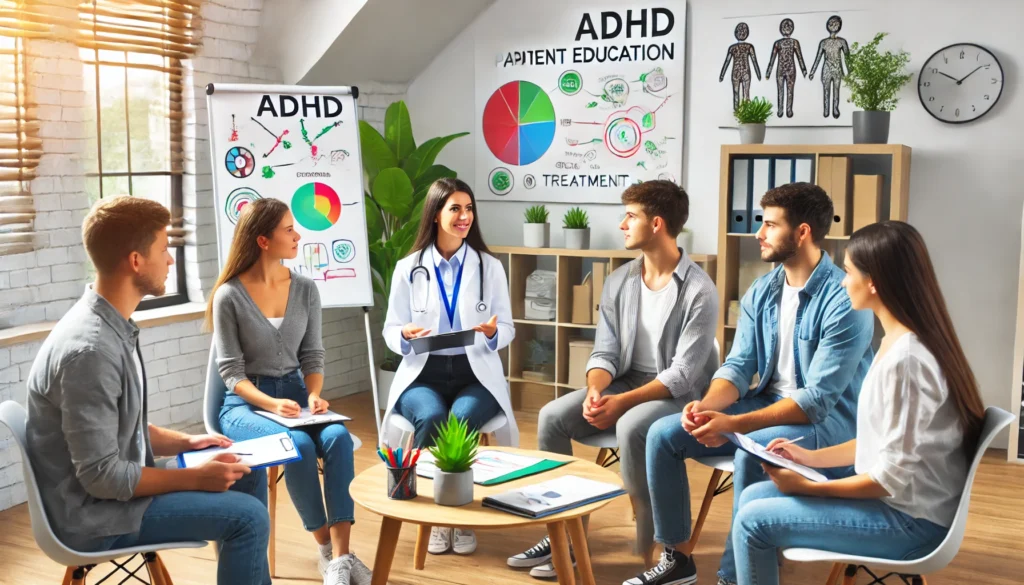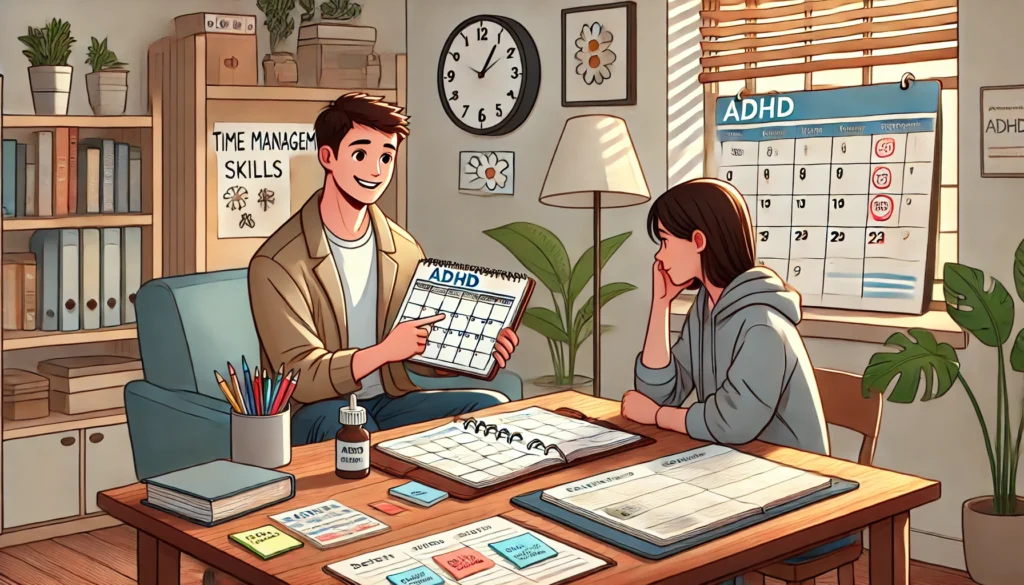Teaching patients with Attention-Deficit/Hyperactivity Disorder (ADHD) requires a nuanced approach that balances scientific understanding with practical strategies. ADHD is a neurodevelopmental disorder characterized by symptoms such as inattention, hyperactivity, and impulsivity. These symptoms can significantly impact a patient’s daily life, making effective education and management strategies crucial. This article explores best practices in ADHD patient teaching, providing insights into developing effective treatment plans, teaching strategies, and fostering a supportive learning environment.
You may also like: Enhancing Concentration: Strategies for ADHD
Understanding ADHD: A Brief Overview
ADHD is more than just an inability to focus; it is a complex disorder that affects brain function and behavior. Historically, ADHD was often misunderstood, with misconceptions about its legitimacy and causes. However, advances in neuroscience have provided a clearer picture of its etiology, highlighting the role of genetic, environmental, and neurological factors.
Historical Misunderstandings of ADHD
In the past, ADHD was frequently dismissed as merely a behavioral issue or lack of discipline. Many believed it was an excuse for poor parenting or a child’s willful disobedience. Such misconceptions led to stigma and inadequate support for individuals with ADHD. Over time, research has dispelled these myths, recognizing ADHD as a legitimate neurodevelopmental disorder.
The Neurobiological Underpinnings
ADHD’s neurobiological basis involves various brain regions associated with attention, impulse control, and executive function. Studies using neuroimaging techniques, such as MRI and PET scans, have shown differences in brain activity and structure in individuals with ADHD. These findings underscore the importance of viewing ADHD through a scientific lens, emphasizing its neurological roots.
The Role of Genetics and Environment
Genetic factors play a significant role in ADHD, with studies indicating a high heritability rate. However, environmental influences, such as prenatal exposure to toxins, premature birth, and early childhood trauma, can also contribute to its development. Understanding this interplay is crucial for tailoring patient education and interventions, highlighting the need for a comprehensive approach.
Recognizing Individual Variability
ADHD symptoms manifest differently across individuals, necessitating personalized approaches in teaching and treatment. While some may primarily experience inattention, others might struggle more with hyperactivity and impulsivity. This variability requires healthcare providers to adopt flexible strategies, considering each patient’s unique challenges and strengths in their educational plan.

Developing an Effective Treatment Plan for ADHD
Creating a treatment plan for ADHD involves a combination of medication, behavioral therapy, and lifestyle modifications. Each patient’s plan should be tailored to their specific needs, symptoms, and lifestyle. Here’s a detailed look at the components:
Medication Management
Medication can play a significant role in managing ADHD symptoms. Stimulants, such as methylphenidate and amphetamines, are commonly prescribed and have been shown to improve attention and reduce hyperactivity and impulsivity. Non-stimulant medications are also available and may be appropriate for some patients.
Understanding Medication Types
Stimulant medications, the most common treatment for ADHD, work by increasing dopamine and norepinephrine levels in the brain, enhancing attention and focus. Non-stimulants, such as atomoxetine and guanfacine, offer alternatives for patients who may not respond well to stimulants or experience adverse effects. Choosing the right medication is a collaborative process, involving careful evaluation and monitoring.
Addressing Side Effects and Concerns
While medications can be highly effective, they may also come with side effects, such as appetite suppression, sleep disturbances, or mood swings. Open communication between healthcare providers and patients is essential to address these concerns. Adjusting dosages or trying different medications may be necessary to find the optimal balance between benefits and side effects.
The Importance of Adherence
Adherence to medication regimens is crucial for achieving desired outcomes. Educating patients and their families about the importance of consistent medication use, even when symptoms improve, can prevent relapse and maintain symptom control. Healthcare providers should regularly review treatment plans to ensure they align with the patient’s evolving needs and lifestyle.
Behavioral Therapy
Behavioral therapy is a cornerstone of ADHD treatment. Techniques such as cognitive-behavioral therapy (CBT) can help patients develop coping strategies, improve organizational skills, and enhance emotional regulation.
Cognitive-Behavioral Strategies
CBT focuses on identifying and changing negative thought patterns and behaviors. For ADHD patients, this might involve learning how to break tasks into smaller, manageable steps or using positive reinforcement to encourage desired behaviors. CBT can also help patients develop problem-solving skills, boosting confidence and self-efficacy.
Parent and Family Involvement
Family involvement is critical in behavioral therapy, as parents and siblings can play a supportive role in managing ADHD. Family therapy sessions can educate loved ones about the disorder, teaching them how to implement consistent routines and positive reinforcement techniques at home. This support system can strengthen the patient’s progress and foster a more understanding environment.
Social Skills Training
Many individuals with ADHD struggle with social interactions, which can lead to feelings of isolation or rejection. Social skills training can address these challenges by teaching patients how to read social cues, engage in conversations, and manage conflicts. Improved social skills can enhance relationships and boost self-esteem, contributing to a better quality of life.
Lifestyle Modifications
Encouraging lifestyle changes can significantly impact ADHD management. Regular physical activity, a balanced diet, and adequate sleep are essential components of a comprehensive treatment plan. Additionally, mindfulness practices, such as meditation and yoga, have shown promise in improving focus and reducing stress.
The Role of Exercise
Physical activity has been shown to improve attention and reduce hyperactivity in individuals with ADHD. Exercise increases the production of neurotransmitters that regulate mood and attention, providing a natural boost to symptom management. Encouraging patients to engage in regular physical activity, such as team sports or dance, can enhance both physical health and mental well-being.
Nutritional Considerations
A balanced diet rich in fruits, vegetables, lean proteins, and whole grains can support brain function and overall health. Some studies suggest that certain dietary changes, such as reducing sugar and artificial additives, may benefit individuals with ADHD. Educating patients and their families about healthy eating habits can empower them to make informed choices that support their treatment plan.
Mindfulness and Relaxation Techniques
Mindfulness practices, such as meditation, deep breathing exercises, and yoga, can help individuals with ADHD develop better focus and emotional regulation. These techniques promote relaxation and stress reduction, creating a sense of calm and balance. Integrating mindfulness into daily routines can enhance the effectiveness of other treatment components and improve overall well-being.

Patient Teaching for ADHD: Key Strategies
Effective patient teaching involves conveying information in a way that is understandable, relatable, and actionable. Here are some strategies to enhance ADHD patient education:
Simplified Communication
Use clear, concise language when explaining ADHD concepts. Avoid medical jargon and break down complex ideas into manageable parts. Visual aids, such as diagrams and charts, can be beneficial in illustrating key points.
Breaking Down Complex Information
Complex medical information can be overwhelming for patients, particularly those with ADHD. Simplifying explanations into bite-sized pieces helps ensure understanding and retention. Using analogies or relatable examples can make medical concepts more accessible, allowing patients to grasp their condition and treatment options more effectively.
Utilizing Visual Aids
Visual aids are powerful tools in patient education, especially for visual learners. Diagrams, flowcharts, and infographics can illustrate how ADHD affects brain function or the steps involved in a treatment plan. These visual representations can reinforce verbal information, making it easier for patients to remember and apply what they’ve learned.
Avoiding Medical Jargon
Medical jargon can create barriers to understanding, leading to confusion and disengagement. When communicating with patients, it’s essential to use everyday language and explain terms when necessary. Encouraging patients to ask questions and seek clarification can also foster a more open and supportive learning environment.
Interactive Learning
Incorporate interactive elements into patient education sessions. Hands-on activities, role-playing, and real-life scenarios can help reinforce learning and make the information more relatable.
Engaging Patients Actively
Interactive learning involves engaging patients actively in the educational process. Activities such as role-playing or problem-solving exercises can make learning more dynamic and memorable. By participating actively, patients are more likely to internalize information and develop practical skills to manage their ADHD.
Real-Life Applications
Applying educational concepts to real-life scenarios can enhance understanding and relevance. For instance, practicing organizational strategies in a simulated work or school environment can help patients translate theoretical knowledge into practical skills. These real-world applications make education more meaningful and directly applicable to daily life.
Gamification and Technology
Incorporating gamification elements, such as quizzes or interactive apps, can make learning about ADHD more enjoyable. These tools can provide immediate feedback and rewards, motivating patients to engage with educational content. Technology-based approaches can also offer flexibility, allowing patients to learn at their own pace and revisit information as needed.
Personalized Approach
Tailor your teaching methods to the individual’s learning style and preferences. Some patients may benefit from auditory learning, while others may prefer visual or kinesthetic approaches. Understanding these preferences can enhance the effectiveness of the education provided.
Assessing Learning Styles
Identifying a patient’s preferred learning style is crucial for effective education. Some individuals may learn best through listening, while others might prefer visual aids or hands-on activities. Assessing these preferences allows healthcare providers to tailor their teaching methods, maximizing engagement and comprehension.
Customizing Educational Materials
Personalizing educational materials to suit individual needs can enhance learning outcomes. For example, providing audio recordings for auditory learners or hands-on activities for kinesthetic learners can make information more accessible. This customization ensures that patients receive education in a format that resonates with them, increasing the likelihood of retention and application.
Flexibility and Adaptation
Flexibility is key when teaching patients with ADHD, as their needs and preferences may change over time. Being open to adapting teaching strategies and materials based on patient feedback can improve the educational experience. Encouraging patients to share their learning preferences and challenges fosters a collaborative approach, enhancing the overall effectiveness of patient education.
ADHD Teaching Strategies: Creating a Supportive Environment
Creating a supportive environment is crucial for effective ADHD teaching. Here are some strategies to foster an encouraging and inclusive setting:
Building Strong Relationships
Establishing a trusting relationship with patients is fundamental. Show empathy, listen actively, and validate their experiences. Building rapport can enhance engagement and motivation, leading to better outcomes.
Empathy and Active Listening
Empathy involves understanding and acknowledging the patient’s feelings and experiences. Active listening demonstrates genuine interest and respect, fostering a sense of trust and openness. This empathetic approach creates a safe space for patients to express their concerns and engage more fully in their education.
Validation and Support
Validating patients’ experiences and emotions helps build a strong therapeutic relationship. Acknowledging their struggles and achievements reinforces their efforts and encourages continued progress. Providing consistent support and encouragement can motivate patients to engage more actively in their education and treatment.
Consistent Communication
Regular communication between healthcare providers and patients is essential for maintaining strong relationships. Scheduled follow-ups and check-ins provide opportunities to address concerns, track progress, and adjust treatment plans as needed. This ongoing dialogue ensures that patients feel supported and informed throughout their ADHD management journey.
Encouraging Self-Advocacy
Empower patients to take an active role in their treatment and education. Encourage them to ask questions, express their needs, and advocate for themselves in various settings, such as school or work.
Fostering Independence
Encouraging self-advocacy involves empowering patients to take charge of their treatment. Teaching them how to articulate their needs and preferences fosters independence and confidence. This skill is particularly important in settings like school or work, where patients may need to request accommodations or support.
Teaching Advocacy Skills
Providing patients with the tools and knowledge to advocate for themselves is crucial. This can include teaching them how to communicate effectively, set boundaries, and seek appropriate resources. Advocacy skills help patients navigate various environments, ensuring they receive the support they need to succeed.
Building Confidence
Confidence is a key component of self-advocacy. Encouraging patients to recognize their strengths and accomplishments can boost their self-esteem. By celebrating small victories and progress, patients are more likely to feel empowered to take an active role in their education and treatment.
Providing Continuous Support
ADHD management is an ongoing process that requires continuous support. Regular follow-ups, check-ins, and adjustments to the treatment plan are essential to address evolving needs and challenges.
Regular Follow-Ups
Scheduled follow-up appointments allow healthcare providers to monitor progress and make necessary adjustments to treatment plans. These check-ins provide opportunities to address any new challenges or concerns, ensuring that the patient’s needs are continually met.
Adaptive Treatment Planning
ADHD symptoms and needs may change over time, necessitating adaptive treatment plans. Being flexible and open to modifying strategies based on patient feedback and progress is crucial. This adaptability ensures that patients receive the most effective and relevant support throughout their ADHD journey.
Community and Peer Support
Connecting patients with support groups or peer networks can provide additional encouragement and understanding. Sharing experiences with others who have ADHD can reduce feelings of isolation and offer practical insights and coping strategies. These communities can be valuable sources of support, complementing professional guidance and education.

The Future of ADHD Education and Management
As research on ADHD continues to evolve, new insights and treatment modalities are emerging. The integration of technology in patient education, such as telehealth platforms and mobile apps, offers innovative ways to deliver information and support.
Technological Innovations in Education
Telehealth platforms and mobile apps are revolutionizing ADHD education, providing convenient access to resources and support. These tools enable patients to learn and engage with content at their own pace, offering flexibility and personalization. Technological innovations also facilitate ongoing communication between patients and healthcare providers, enhancing the overall treatment experience.
Advances in Genetic Research and Neuroimaging
Genetic research and neuroimaging are paving the way for more personalized ADHD management strategies. Understanding the genetic and neurological underpinnings of ADHD can lead to targeted interventions and treatments. These advances hold promise for developing more precise and effective approaches to patient education and care.
Staying Informed and Adapting to Change
Staying informed about the latest research and developments in ADHD is crucial for healthcare providers. By keeping up-to-date with emerging trends and treatment modalities, providers can continuously refine their teaching approaches. Adapting to change and embracing new insights ensures that patients receive cutting-edge solutions and support.
Conclusion
Teaching patients with ADHD is a dynamic process that requires a balance of scientific knowledge and practical application. By understanding the complexities of ADHD, developing individualized treatment plans, and employing effective teaching strategies, healthcare providers can empower patients to manage their symptoms and lead fulfilling lives. As we continue to uncover the intricacies of this disorder, ongoing education and adaptation will be key to supporting individuals with ADHD in achieving their full potential.
Further Reading:
ADHD in the Classroom: Helping Children Succeed in School
Attention Deficit Hyperactivity Disorder
Attention-Deficit/Hyperactivity Disorder (ADHD)
Important Note: The information contained in this article is for general informational purposes only, and should not be construed as health or medical advice, nor is it intended to diagnose, prevent, treat, or cure any disease or health condition. Before embarking on any diet, fitness regimen, or program of nutritional supplementation, it is advisable to consult your healthcare professional in order to determine its safety and probable efficacy in terms of your individual state of health.
Regarding Nutritional Supplements Or Other Non-Prescription Health Products: If any nutritional supplements or other non-prescription health products are mentioned in the foregoing article, any claims or statements made about them have not been evaluated by the U.S. Food and Drug Administration, and such nutritional supplements or other health products are not intended to diagnose, treat, cure, or prevent any disease.


